Since pranging my back a couple of weeks ago I have become something of an aficionado of public seating provision in Leeds City Centre. I don’t mean an impressionistic “I like this one”, “I don’t care much for that”, sort of thing; when you live in constant fear that you may be forced to sit down before you fall down in a busy lunchtime street the availability of decent resting arrangements can assume the importance of an obsession. I have done some serious thinking and research too, even read the odd book. Not while actually sat on any public seat it has to be said. Have you seen the weather?
The book I’ve mostly been reading this week is City: Rediscovering The Center, by William Hyde Whyte – an American, so let the spelling mistake pass – which has a lot to say about public seating, amongst other pressing questions of urban design. I picked this particular book up again because of the recent posts on Culture Vulture about future cities and the city centre. I’m not a conference-hopping consultant so I didn’t feel I had anything smart to say about the future city, and the last official document I read was in Cuneiform, so I didn’t really feel I could comment directly on James Blythman’s detailed and erudite contribution. I do know quite a bit about obscure old books, however. Whyte may not be as infamous as Jane Jacobs, and never got as influential (and wealthy) as Richard Florida, but for my money he wrote some of the wittiest and most illuminating books ever about city life (and seats.)
Whyte is the poet of urban walking (see the chapter The Skilled Pedestrian where he talks about jaywalkers in his favourite city; “Ones admiration for the bravado of the New York pedestrian must be tempered by his frequent extinction”,) and unlike many urban theorists, he loves cities and city dwellers who generally do not behave like planners, designers and architects would prefer (Read The Best Street Life In The World: Why schmoozing, smooching, noshing, ogling are getting better all the time, p26 – what a bloody good title too!). And he’s unmatched when it comes to writing about how people use public space, and how developers often just don’t get it.
In the chapter, The Design of Spaces, he talks a lot about the simple act of sitting down in a city street, why some places are inviting, why many fail, and how designers need to learn to look at how people naturally use spaces and build around what works.
I’m not going to go into much detail of his analysis – go read the book – instead I’m going to take a walk through Leeds using Whyte’s method of just looking at places long and hard and noticing what goes on…
I started at City Square, Leeds’s greatest public plaza. Except it isn’t. Basically it’s a glorified traffic island. There is some fairly decent public seating – and plenty of ledging for the more adventurous – but it’s around the sides closest to the traffic and though it does get used a lot it’s nowhere near as suitable a location as the more sheltered area near the old post office building. Sadly this prime piece of public space – almost a quarter of the square – is now frequently behind barriers, and unless you can afford the pricey restaurant food and enjoy eating fish (neither of which applies to me) you are reduced to gazing longingly at those very appealing chairs. People who use the metal seats tend to be eating a packed lunch, throwing crusts at the pigeons. I noticed yesterday that the restaurant had removed the barrier – and the comfy, sociable seating, presumably for the winter?
Over the road in The Bond Street Centre it’s probably even worse. The place is a shrine to Leeds’s twin obsessions – shopping and security. There are no seats at all. You are meant to keep moving here, from shop to shop, until you emerge back onto the street, loaded with bags, looking for a bus stop. Not so long ago a diabetic friend bought a sandwich from Boots and leaned against the wall directly outside. She’d barely taken a second bite before we were moved on. She was informed that she could not consume food in this private space as standing still “caused a hazard.” Apparently the shoppers here are so consumer crazed they wouldn’t notice a couple of tall people discretely having lunch well out of the main pedestrian flow and would be in danger of mowing them down in a blind retail frenzy. I’ve been told this does happen, but I think it could simply be an urban myth.
The bottom of Albion Street is narrow and looking like it will get narrower owing to the Trinity development – though people do stop here and chat even with noisy building work going on around them. (Read Whyte on the 100% conversation to understand what that’s about.) The seats further up past Next do get used but not for lengthy, leisurely stays. Many of the occupants of these benches are men waiting for their better half to emerge from a shop, and they sit on the arm or the back of the seat facing away from the shops as if to emphasise that they are in the street but not of it.
Nobody in their right mind wants to sit on those stone and marble things on Albion Street and Albion Place. I saw an old couple attempting to take the weight of their feet jump up in a flash and dust the back of their pants as if they’d just sat in something dismaying. The seats are hard, cold, often wet – a slab of stone in a Northern climate may be not the right choice of seating material – and unbearably unforgiving on the back. These are architectural forms, built to please the eye, not to ease the bottom. My guess is that they are only used when every other space is taken, and grudgingly.
The oddest public seating has to be on Vicar Lane. They look like playground roundabouts, though a roundabout would get more use. I thought it was telling that a couple of guys chose to lean on a waste bin to talk than sit down on one of these things only inches away. The problem is, I think, they are simple anti-social – you are forced to face away from the person next to you, which makes it hard to talk, but you are also too close if you want to be on your own. The design pleases nobody. Whenever you do see a group of people near these things only one tends to be sitting and the rest are stood up, which kind of defeats the object.
The best physical space for sitting has to be in the Victoria Quarter. And this is probably my favourite seat, perfect in every way, but as this photo shows, you can’t please everyone. Get your bag off the chair, mate!
Even the ledges in this place are filled with people, eating, drinking and socialising. True, it’s a private space but mooching is tolerated and nobody seems to mind if you can’t afford lunch from Harvi Nicks, you can still sit on the benches with a sandwich.
The most used place to sit by far is on Briggate. And I’m not sure why the seating works so well – they aren’t especially comfortable, attractive, or even well placed – but they are nearly always full and people seem happy to sit there for hours. If anyone can tell me the secret of this seating I’d be a happy man, and I wish we could have some more of it. I think I’ll leave the last word with William H Whye, who as always says it better than I ever could;
It is difficult to design a space that will not attract people. What is remarkable is how often this has been accomplished.
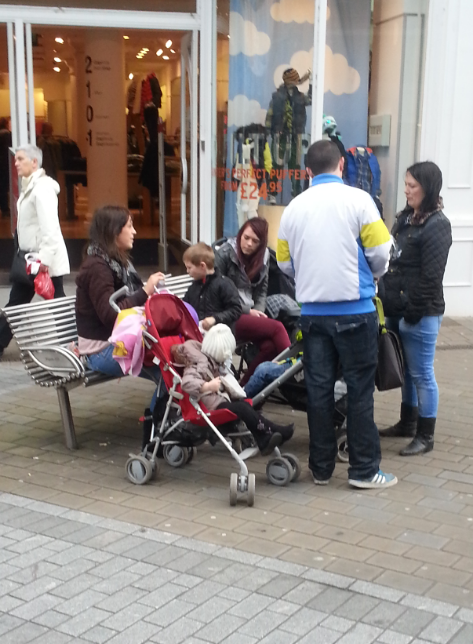
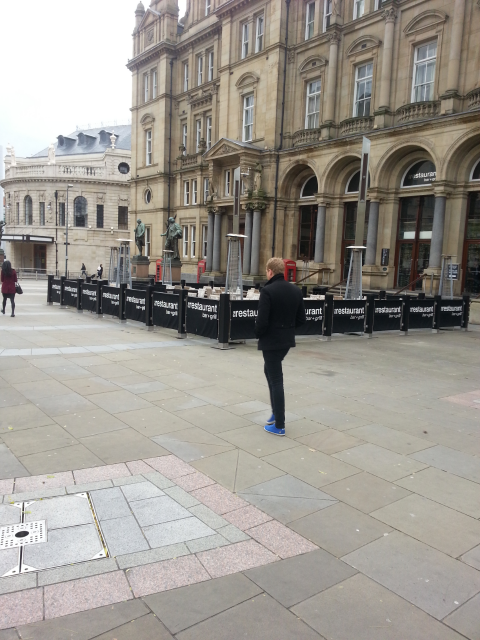
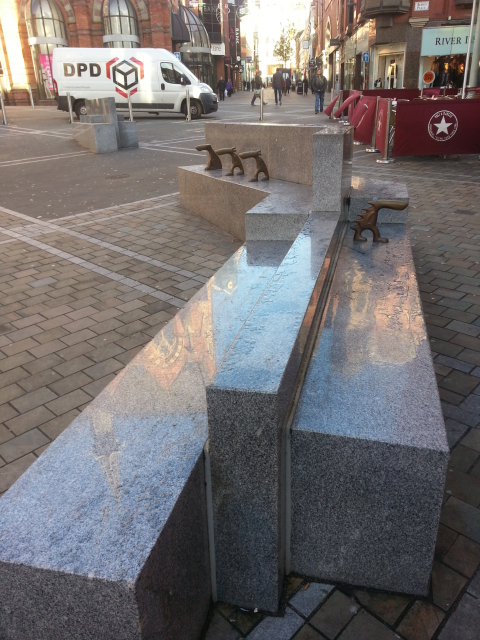
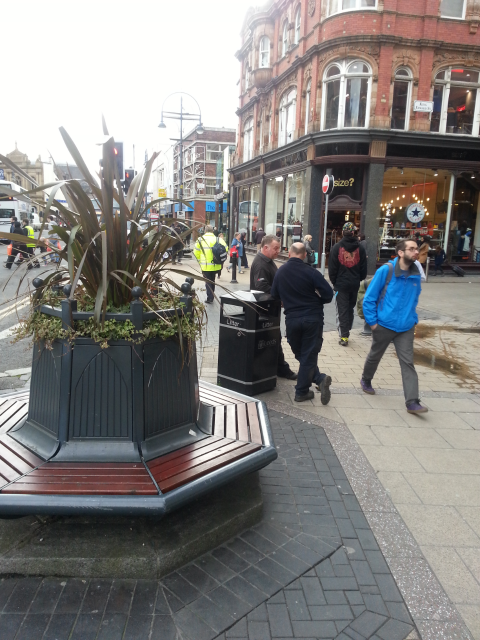
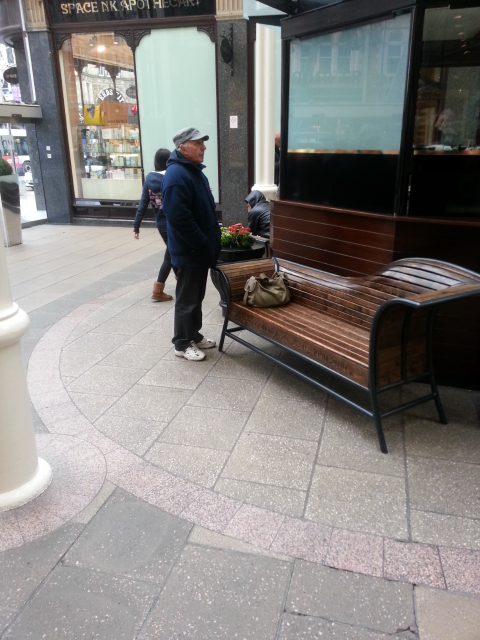
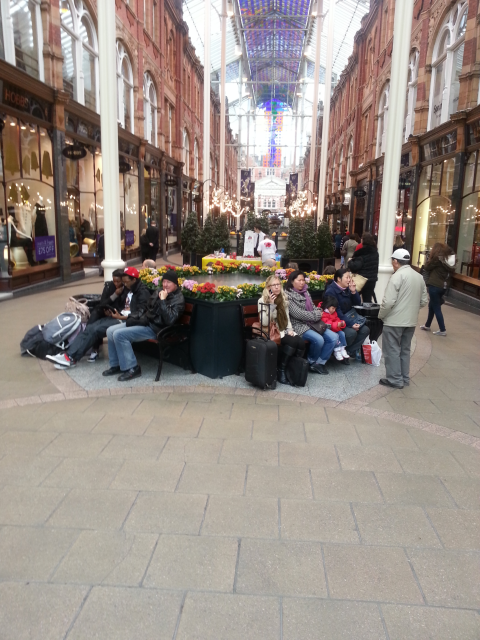
Have you ever noticed the seating arrangements immediately outside of MacDonalds on Briggate? Be sure to look next time you pass. Reminds me of the apocryphal death of Edward II
I don’t know about apocryphal, but ouch!